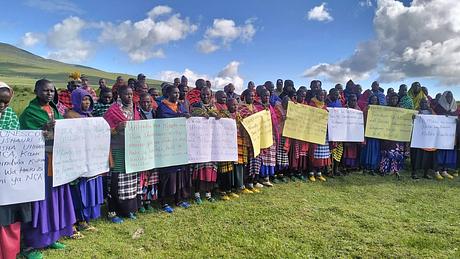Tribal peoples across India join forces to denounce Protected Areas on their lands.
March 24, 2023

Hundreds of Indigenous (Adivasi) people from Protected Areas across India joined forces in Nagarhole Tiger Reserve in southwest India for an unprecedented week-long protest march against the seizing of their lands to create so-called ‘Protected Areas’ for conservation, including tiger reserves.
The protest was centered on the world-famous Nagarhole Tiger Reserve, which was imposed, without consent, on the ancestral land of the Jenu Kuruba, who are renowned for their prowess as honey collectors, as well as the Beta Kuruba, Yarava and Pania tribes.
While Protected Areas welcome in foreign tourists, Adivasis are refused entry and barred from their forests. In tiger reserves across India, tribal people have been evicted from their ancestral lands or are threatened with eviction in the name of conservation. They also face killings, violent assault and harassment.
Nagarhole is now bordered by coffee plantations, surrounded by electric fences. There are significant overlaps between plantation owners, tourism operators and the local 'conservation' lobby.’ Jadeya, one of the protesters, explained: "The electric fences are not to protect the animals but to prevent them from entering the coffee plantations, and to keep people out of their own lands."
For many tribal people, being thrown off their lands results in destitution. Many Adivasis end up working in local coffee plantations, in what the protesters described as almost slave-like conditions. Speaking from the march, Arjun, from the Bhunjia community in Udanti-Sitanadi Tiger Reserve, said: “The estates make Adivasis slaves on their own lands."
The marchers stopped every day at sacred sites which had been stolen from them. In what they saw as an attack on both their beliefs and land rights, the protesters found that many of the sites had been covered by Hindu symbols.

The marchers are highlighting:
- The wave of human rights abuses against them, including killings and assaults, stemming from the growing militarization of conservation
- The central role played by organizations like the Wildlife Conservation Society (WCS), WWF, Wildlife Protection Society of India, Wildlife Trust of India, Wildlife First, and Conservation International in a conservation model that destroys their communities.
- The evictions that violate their rights under national and international law.
- Their demand to live on their own lands, upon which Protected Areas are imposed, and for evictions to end.
While conservation organizations and officials claim that “relocations” are “voluntary”, research shows that in reality tribal people are harassed, threatened and intimidated into 'agreeing' to leave – in violation of international law.
The resistance in Nagarhole is continuing in the form of an indefinite protest involving Adivasis from 46 villages now being held in front of the Forest Department Offices of the Tiger Reserve. It will continue until the demands of the communities are met.
One of the slogans chanted during the march was, “The Nagahole forests belong to our ancestors. The animals and forests are part of us – our families”.
The march was followed by a two-day “inter-communities dialogue” on resistance to Protected Areas, in Bangalore from March 22nd to 23rd entitled, “Debunking the idea of Protected Areas - Community ownership of forests and commons …. where forest, peoples and animals are equals.” (Their demands are here).
Survival’s Director Caroline Pearce said today: “This protest is a powerful statement from the Adivasi peoples who have, for far too long, been evicted and abused in the name of conservation.Their shared experiences of violence and dispossession make it painfully clear that this is systemic abuse, endemic to the colonial and militarized model of conservation practiced in India and elsewhere. This inspiring resistance movement is part of a struggle that goes beyond national boundaries and laws. It is a struggle for the survival of Indigenous people and their ways of life.”
Note to Editors: Survival has photos and video of the protests, and can arrange interviews with those involved.
The march (known in India as a ‘Padayatra’) was joined by people from many Protected Areas including Kaziranga, Similipal, Achanakmar, Udanti-Sitanadi and Nagarhole.


